With the growth in mobile app development and a lot of people interested in the same, there’s one important thing everyone should know about, mobile app architecture.
Reports from Mobile App Trends 2023 suggest, there’s been 31% year-over-year and user engagement. And with the growth in the industry, there are more than 2.22 million apps on the Apple App Store and 3.48 million apps on the Google Play Store.
So, if you are someone who wants to create a mobile app for your business like TikTok, Instagram, Doordash, or any other, you should definitely understand what mobile app architectures are, in this mobile app architecture guide.
Therefore, without further ado, let’s get right into it, starting with the basics:
What is Mobile App Architecture?
Mobile app architecture…
Sounds important right? Well, it is. It is very important.
Mobile app architectures are structural designs and organized mobile apps. The architecture deals with the arrangement and interaction between the different components and modules.
As such, a well-built architecture allows code reusability, maintainability, scalability, and extensibility. Therefore, making it easier for developers to create, test and maintain the concerned application.
For these exact reasons, architecture is one of the most important parts of mobile app development.
Mobile App Architecture vs Mobile App Tech Stack
Now, mobile app architecture is confused with mobile app tech stack more often than you think. And even though the two concepts have things in common, they aren’t the same thing at all.
For instance, a tech stack refers to the technologies like languages, frameworks, toolkits, etc used for app development. Coming to mobile app architecture, we already discussed what they are.
In short, architecture concerns every component of the app and also covers outside elements like business requirements.
This is the difference between app architecture and app tech stack.
Now, there can be different types of mobile app architecture patterns that you commonly see in the industry.
Commonly Used Mobile App Architecture Patterns
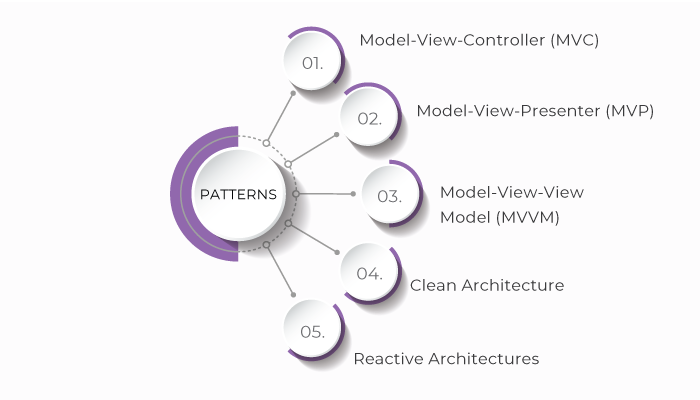
Every mobile app has its own different needs and that’s why they require different mobile app architectures. However, regardless of the type, architecture has to follow mobile app architecture patterns.
While a custom development team can create their own pattern as well, there are some pre-set patterns to create mobile app architecture.
Here, we will discuss them. These are, as mentioned below:
Model-View-Controller (MVC)
This pattern separates the app into three main components:
- the model (data and business logic)
- the view (user interface)
- the controller (mediator between the model and view).
It is one of the most commonly used app architecture patterns that you see in a lot of
Model-View-Presenter (MVP)
Similar to MVC, MVP mobile app architecture patterns separate the app into model, view, and presenter components. Moreover, the presenter acts as an intermediary between the model and the view.
The pattern handles user interactions and updates the UI. ( this MVP should not be confused with MVP – minimum viable product )
Model-View-ViewModel (MVVM)
MVVM is a mobile app architecture pattern where the model represents the data and business logic, the view displays the UI, and the view model acts as a bridge between them. Thus, providing data to the view and handling user interactions.
Clean Architecture
This mobile app architecture pattern emphasizes the separation of concerns and dependency inversion. It consists of layers such as presentation, domain, and data, with each layer having its own responsibilities and dependencies.
Reactive Architectures
These architectures, such as ReactiveCocoa or RxJava, enable reactive programming paradigms. They allow for handling asynchronous operations and data streams by using observable sequences and reacting to changes.
With the patterns out of the way, we shall be discussing the commonly used types of mobile app architecture in the section below.
Types Of Mobile App Architecture
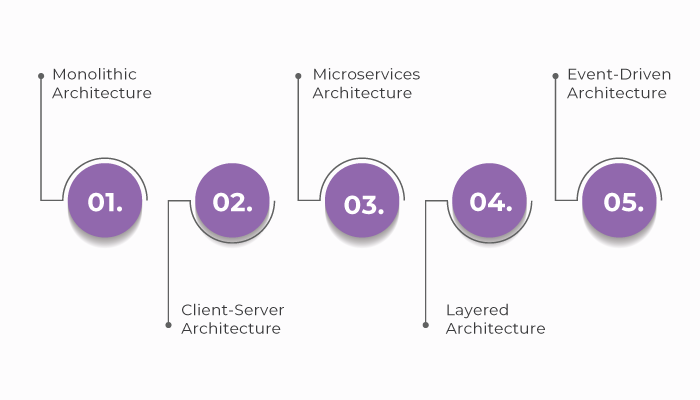
Each business app development project has its own unique needs and thus requires a specific mobile app solution architecture to fulfill its needs.
Consequently, there are different types of mobile app system architecture available in the market. You can either choose one of these or create one of your own. ( we will discuss that later down the line)
Speaking of which, let’s look at some commonly used app architecture.
Monolithic Architecture
Here, the entire mobile app is developed as a single, self-contained unit. Thus, the name monolithic app architecture.
Moreover, all the modules and components of the app are tightly coupled and run within a single process. As such, it is relatively simple and easy to develop but can become difficult to maintain and scale as the app grows.
Due to that, it is falling out of favor.
Client-Server Architecture
In a client-server mobile app architecture, the solution is a client that communicates with a server over a network.
The server handles tasks such as data storage, business logic, and processing, while the client app focuses on user interface and user interaction.
The benefits you get with this one are better scalability and separation of concerns.
Microservices Architecture
Microservices architecture is the one used by top platforms like Netflix, Amazon, and Instagram.
This mobile app architecture enables apps to be a combination of smaller and independent services known as microservices.
Each microservice focuses on a specific business function and can be developed, deployed, and scaled independently.
Communication between microservices typically occurs through APIs or message queues.
Therefore, this mobile app architecture allows for high scalability, fault isolation, and flexibility, but it adds complexity in terms of service coordination and deployment.
Layered Architecture
As the name suggests, here the app is divided into multiple later.
Each layer is responsible for a specific set of functions. Common layers include presentation, business logic, and data access. We shall be discussing the various layers of architecture later down the line.
This architecture promotes separation of concerns, modular development, and ease of testing.
Event-Driven Architecture
The event-driven architecture enables different components to communicate using events.
Therefore, when an event occurs, it triggers a message to the other concerned component. The technology is especially recommended for real-time i.e. on-demand apps.
Layers Of Mobile App Architecture
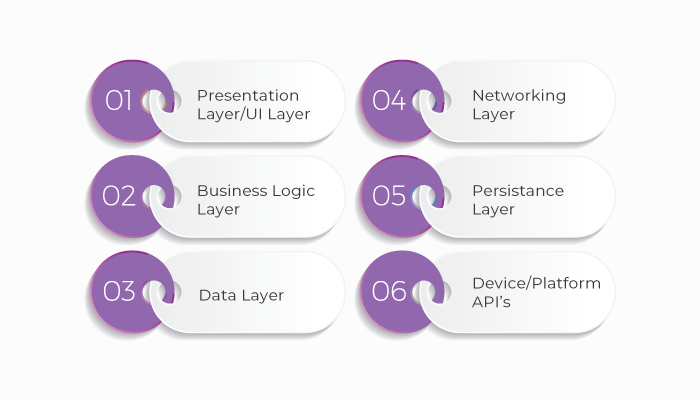
To understand the working of mobile app architecture, one must first understand the different layers of the technology.
Therefore, in this blog, we shall be discussing exactly this:
Presentation Layer/UI Layer
This layer of architecture deals with the user interface. This covers parts like screen, viewing, as well as user interactions.
And it is responsible for handling user input, information display, as well as communication with the other layers of architecture.
As such, the latter covers components like fragments (Android), view controllers (iOS), or widgets.
Business Logic Layer
As the name implies, it is one of the most important layers of app architecture. As such, it houses all the core functionalities and the app’s rules.
It goes without saying, it is also responsible for business logic implementation, algorithm working, and manipulation of data.
With this level of authority over the application, this layer manages the app’s behavior, defining how data is used. Lastly, it is also the layers that work as a barrier between the presentation layer and the data layer.
Data Layer
Appropriately named, this layer deals with data synchronization, storage, and retrieval. To enable this, it has components like data models, repositories, and data access objects
For that reason, this layer is responsible for communication with external data storage, APIs, as well as the database.
Networking Layer
The networking layer deals with, well, networking.
It communicates with the API and other external services. Thus, it is responsible for handling HTTP requests, sending/receiving data, and managing network connectivity.
Persistence Layer
This is a little more technical as this layer deals with data persistence, data storage ( on-device), database management, file storage, caching, and so on.
It is the persistence layer that enables offline functionality and data synchronization at a larger level.
Device/Platform APIs
Well, today, each mobile app has APIs to enable additional functionality. And it is this layer of functionality that enables API interaction.
So, these are the different layers of mobile app information architecture. And with this out of the way, let’s move on and check how you can choose the right mobile app architecture.
How To Choose Mobile App Architecture?
How do you choose the right architecture for your mobile app? Well, it can be difficult to put a finger on one mobile app architecture, especially when you are new to it.
To help you, we shall be discussing all you need to know about choosing the right architecture in this section. Covering everything from examples to things to consider.
Popular Mobile Apps And Architecture They Use
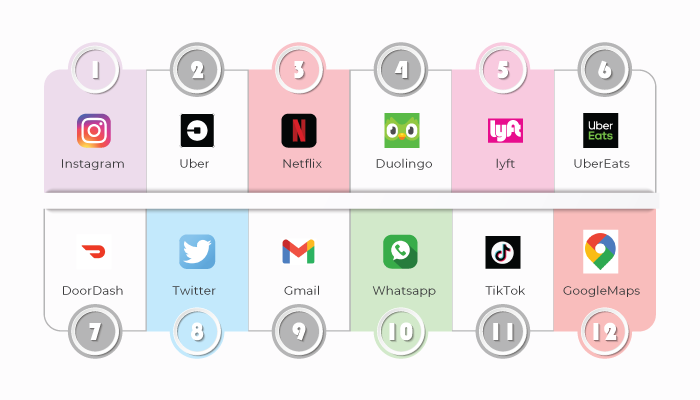
If you are developing an app like Instagram or Uber Clone app, then it will be beneficial for you to learn about the architecture those apps use.

So, the mobile app architecture example is, as mentioned below:
- Instagram: a client-server architecture
- Uber: microservices architecture
- Netflix: cloud-native architecture
- Duolingo: service-oriented architecture (SOA)
- Lyft: microservices architecture
- UberEats: microservices architecture
- DoorDash: microservices architecture
- TikTok: client-server architecture
- WhatsApp: client-server architecture
- Twitter: service-oriented architecture (SOA)
- Gmail: client-server architecture and distributed systems
- Google Maps: client-server architecture and distributed systems
With this out of the way, let’s look at the things that you should consider when choosing mobile app software architecture.
Things To Consider When Choosing Mobile App Architecture
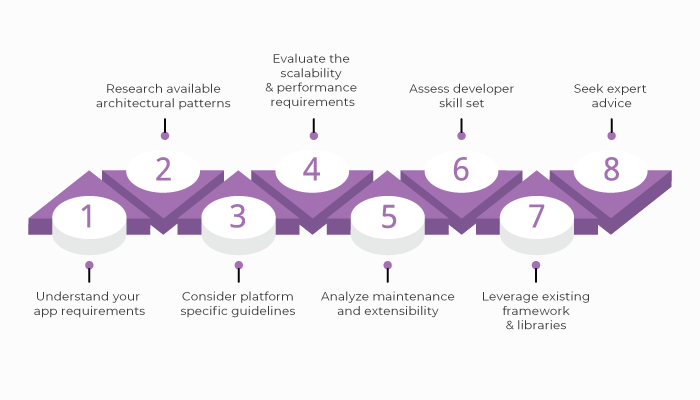
There are many things that you should consider when choosing the right architecture for a mobile app. These are, as mentioned below:
· Understand your app requirements
The first thing you need to do is understand the requirement of the app project. Therefore, you should consider:
- App complexity
- Expected traffic
- Real-time update requirements
- Specific security requirements
- Specific functionality or performance
Considering this architecture helps you choose the architectural patterns for your solution.
· Research available architectural patterns
We discussed a number of architectural patterns at the beginning of the blogs. Now, you need to decide which one to use for your app development project.
Each mobile app architecture pattern has its own pros and cons. So, research it, and finalize which sits well with your project.
· Consider platform-specific guidelines
Well, when you are developing a mobile app, you go with one of these options”
- hybrid mobile app architecture
- android mobile app architecture
- flutter mobile app architecture
- ios mobile app architecture
Each of the platforms has its one unique requirement. Let’s discuss this in detail later.
Coming back to the topic, it’s essential to consider the platform-specific guidelines and best practices. These guidelines can influence your architectural choices and ensure your app integrates well with the platform ecosystem.
· Evaluate the scalability and performance requirements
Are you considering the operations to grow? Well, if yes, you should definitely think about potential scalability and performance requirements.
You see, if you expect a large number of users or anticipate the need for frequent updates and real-time interactions, you might need an architecture that supports scalability and responsiveness.
· Analyze maintenance and extensibility
You should definitely think about the long-term maintenance and extensibility of your app.
Choose an architecture that allows for easy maintenance, modular development, and the ability to add new features without introducing significant code changes or risking stability.
· Assess developer skill set
At the end of the day, it’s mobile app developers who will convert your idea into reality.
So, when choosing mobile app architecture, you need to consider their skill set and preferences.
Choosing an architecture that your team is comfortable with will streamline the development process and help ensure the quality of the codebase.
· Leverage existing frameworks and libraries
Evaluate the availability of frameworks, libraries, and tools that can support your chosen architecture.
Using established frameworks and tools can significantly reduce development time and provide a solid foundation for your app.
· Seek expert advice
The best thing to do is, contact an app development company. They will give you expert advice and make the choice for architecture that much easier.
Conclusion
Mobile app architecture plays an important role in mobile app development. In this blog, we discuss everything related to architecture from patterns to common examples as well as how to choose one for you. Now, you are ready to choose the right app architecture for the app and create the next best app.
FAQ
The architecture of a mobile app refers to its overall design and structure, including how its components are organized and interact with each other. It determines how the app handles data, user interface, network communication, and other essential functionalities.
The best architecture for a mobile app depends on factors such as app complexity, platform (e.g., Android or iOS), development team expertise, and project requirements. Some commonly used architectures for mobile apps include Model-View-Controller (MVC), Model-View-ViewModel (MVVM), and Clean Architecture.
The key components of a mobile app architecture typically include:
- User Interface (UI): Handles the presentation layer and user interactions.
- Business Logic: Contains the application’s core functionality and rules.
- Data Layer: Manages data storage, retrieval, and synchronization.
- Networking: Handles communication with external services or APIs.
- Navigation: Controls the flow and transitions between app screens or views.
There are various mobile application architectures, but two commonly used ones are:
Native Architecture: Involves developing separate codebases for different platforms (e.g., Java/Kotlin for Android and Swift/Objective-C for iOS). It offers high performance and platform-specific capabilities but requires more development effort.
Cross-Platform Architecture: Involves using frameworks like React Native, Flutter, or Xamarin to develop a single codebase that can run on multiple platforms. It provides code reusability and faster development but may have some performance trade-offs.

Udai Singh is a senior content writer with over 6 years of experience in creating content for FinTech, eWallet, EdTech, and App Development. He is an expert in simplifying complex concepts and creating engaging content that resonates with the audience.
Table of Contents













No Comments
Comments are closed.